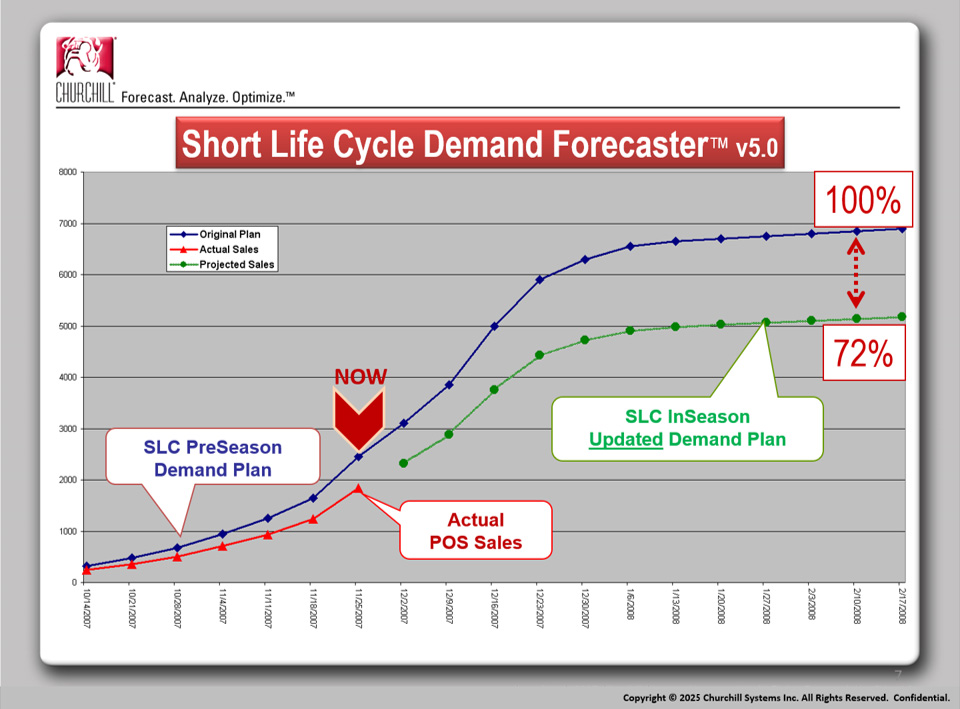Short Life Cycle Demand Forecaster™ (SLC)
Get precise, SKU-level demand-based forecasts for seasonal, event-driven, and unique products to maximize profitability and reduce risks associated with seasonal product management.
Churchill’s Short Life Cycle Demand Forecaster™
A Demand-Based Forecasting Foundation for Seasonal Merchandise
Short Life Cycle Demand Forecaster™ (SLC) provides retailers the demand intelligence to plan and react to consumer behavior specifically for seasonal items, across all areas of the business — from Merchandising to Price Planning and Promotions to Supply Chain. Churchill’s SLC software generates sophisticated, detailed consumer demand forecasts for any number of retail planning applications, including:
- Merchandise Planning / Open To Buy
- Store Allocation and Replenishment
- Promotions Planning and Execution
- Price Optimization


Demand-Based Forecasting
Planning for Short Life Cycle Success
SLC automates Preseason and Inseason forecasting to address several key areas of the seasonal product lifecycle. Unique types of AI technology are used to develop forecasts for 1) initial buy quantities, 2) store-based allocation, 3) ongoing replenishment, and 4) markdown pricing actions. Here are some of the features:
- Full season demand values within the first few weeks of sales
- Specific technology for each phase of the life cycle
- “Lost sales” calculations capture unmet demand
- Extensive reporting
- Extreme scalability for high volume retailers
- Full integration without disruption to existing systems
Complexity of Short Life Cycle Products
Gain Control Over Fluctuating Demand, Evolving Trends, and Seasonal Variations
It is common for this year’s short life cycle merchandise to be a ”new” or “different” version of the SLC item or class that was sold during previous years. Complicating things further, the events or holidays vary by calendar day and even week each year, while other variable factors may be based on weather or fashion trends. The challenge of managing short life cycle items is the need to buy, allocate, price, promote and markdown in an optimized manner.
Demand-Driven Planning
Create initial plans based on demand, not outdated sales data, ensuring your inventory matches expected consumer needs.
Could-Sell” Bottom-Up Planning
Build inventory plans from the ground up, focusing on potential sales opportunities to capture true demand at every level.
Seamless Integration
Works with your current planning software, making it simple to implement without disrupting established workflows.
Efficient High-Volume Planning
Easily manage large-scale planning for seasonal items, regardless of volume or complexity.
Real-Time Seasonal Adjustments
Update plans daily or weekly throughout the season based on actual demand, allowing for quick adjustments that reduce overstock and stockouts.
Proactive Identification of Supply Imbalances
Identify at-risk items or stores early, enabling timely price and inventory adjustments to prevent excess supply or shortages.
Recommended Reads
Why Retailers Struggle to Adopt Better Forecasting (And How to Overcome it)
Better demand forecasting isn’t a dashboard upgrade — it’s a profit engine. When you tighten error and bias, you sell more at full price, carry less inventory, cut expedites and chargebacks, and free planners from spreadsheet firefighting. So, Where Does Demand Forecasting Actually Pays Off? Read this blog and explore.
Where Demand Forecasting Actually Pays Off
Better demand forecasting isn’t a dashboard upgrade — it’s a profit engine. When you tighten error and bias, you sell more at full price, carry less inventory, cut expedites and chargebacks, and free planners from spreadsheet firefighting. So, Where Does Demand Forecasting Actually Pays Off? Read this blog and explore.
Why Sell-Through Forecasting Is Retail’s Most Underrated Advantage
Most retailers track sell-through, but few forecast it. This article explores why Sell-Through Forecasting is one of retail’s most overlooked tools — and how it helps retailers allocate smarter, reduce markdowns, and protect margin by acting earlier in the product lifecycle.